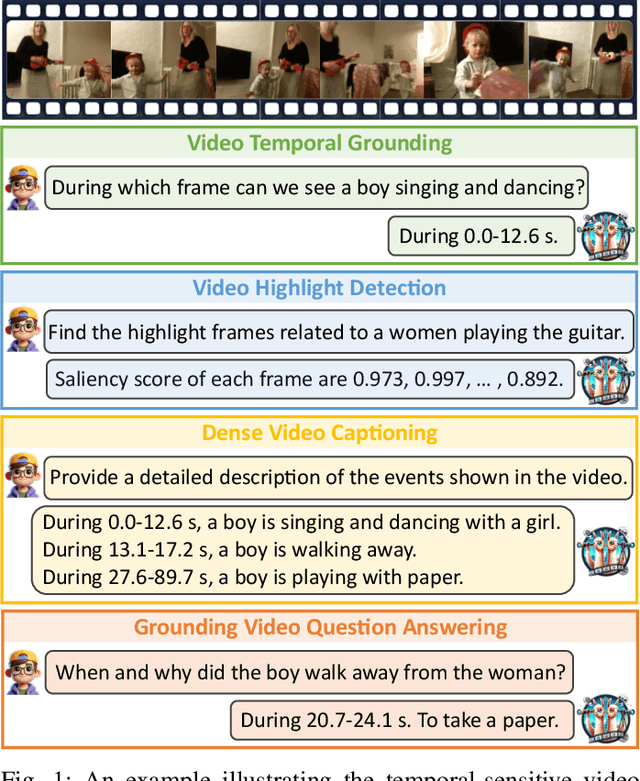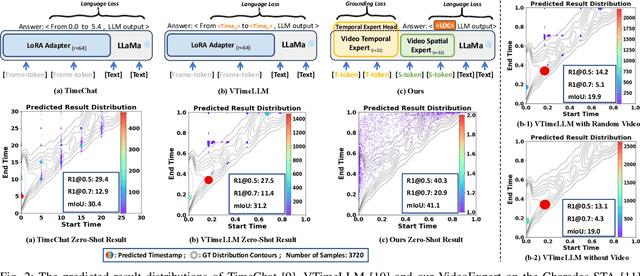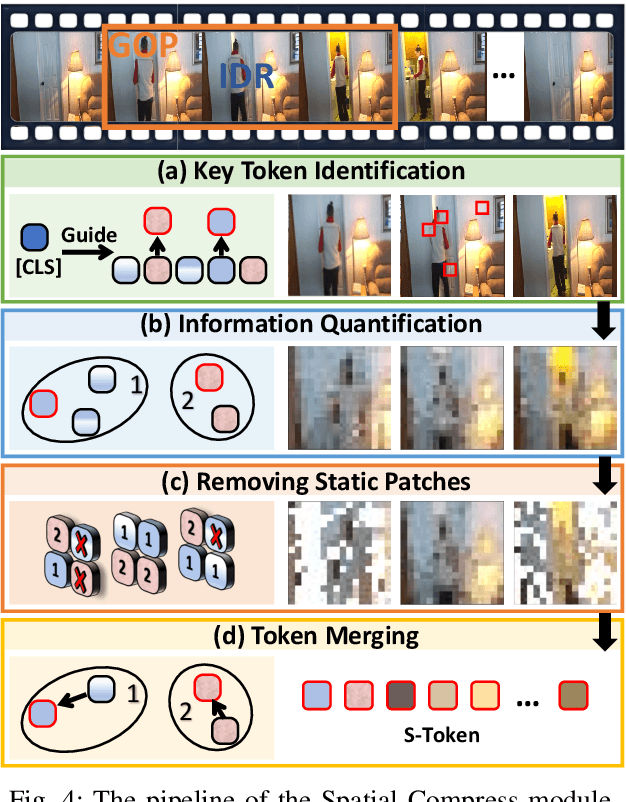Zechao Li
Gradient Short-Circuit: Efficient Out-of-Distribution Detection via Feature Intervention
Jul 02, 2025Abstract:Out-of-Distribution (OOD) detection is critical for safely deploying deep models in open-world environments, where inputs may lie outside the training distribution. During inference on a model trained exclusively with In-Distribution (ID) data, we observe a salient gradient phenomenon: around an ID sample, the local gradient directions for "enhancing" that sample's predicted class remain relatively consistent, whereas OOD samples--unseen in training--exhibit disorganized or conflicting gradient directions in the same neighborhood. Motivated by this observation, we propose an inference-stage technique to short-circuit those feature coordinates that spurious gradients exploit to inflate OOD confidence, while leaving ID classification largely intact. To circumvent the expense of recomputing the logits after this gradient short-circuit, we further introduce a local first-order approximation that accurately captures the post-modification outputs without a second forward pass. Experiments on standard OOD benchmarks show our approach yields substantial improvements. Moreover, the method is lightweight and requires minimal changes to the standard inference pipeline, offering a practical path toward robust OOD detection in real-world applications.
SpectralGap: Graph-Level Out-of-Distribution Detection via Laplacian Eigenvalue Gaps
May 21, 2025Abstract:The task of graph-level out-of-distribution (OOD) detection is crucial for deploying graph neural networks in real-world settings. In this paper, we observe a significant difference in the relationship between the largest and second-largest eigenvalues of the Laplacian matrix for in-distribution (ID) and OOD graph samples: \textit{OOD samples often exhibit anomalous spectral gaps (the difference between the largest and second-largest eigenvalues)}. This observation motivates us to propose SpecGap, an effective post-hoc approach for OOD detection on graphs. SpecGap adjusts features by subtracting the component associated with the second-largest eigenvalue, scaled by the spectral gap, from the high-level features (i.e., $\mathbf{X}-\left(\lambda_n-\lambda_{n-1}\right) \mathbf{u}_{n-1} \mathbf{v}_{n-1}^T$). SpecGap achieves state-of-the-art performance across multiple benchmark datasets. We present extensive ablation studies and comprehensive theoretical analyses to support our empirical results. As a parameter-free post-hoc method, SpecGap can be easily integrated into existing graph neural network models without requiring any additional training or model modification.
Diff-MM: Exploring Pre-trained Text-to-Image Generation Model for Unified Multi-modal Object Tracking
May 19, 2025Abstract:Multi-modal object tracking integrates auxiliary modalities such as depth, thermal infrared, event flow, and language to provide additional information beyond RGB images, showing great potential in improving tracking stabilization in complex scenarios. Existing methods typically start from an RGB-based tracker and learn to understand auxiliary modalities only from training data. Constrained by the limited multi-modal training data, the performance of these methods is unsatisfactory. To alleviate this limitation, this work proposes a unified multi-modal tracker Diff-MM by exploiting the multi-modal understanding capability of the pre-trained text-to-image generation model. Diff-MM leverages the UNet of pre-trained Stable Diffusion as a tracking feature extractor through the proposed parallel feature extraction pipeline, which enables pairwise image inputs for object tracking. We further introduce a multi-modal sub-module tuning method that learns to gain complementary information between different modalities. By harnessing the extensive prior knowledge in the generation model, we achieve a unified tracker with uniform parameters for RGB-N/D/T/E tracking. Experimental results demonstrate the promising performance of our method compared with recently proposed trackers, e.g., its AUC outperforms OneTracker by 8.3% on TNL2K.
VideoExpert: Augmented LLM for Temporal-Sensitive Video Understanding
Apr 10, 2025



Abstract:The core challenge in video understanding lies in perceiving dynamic content changes over time. However, multimodal large language models struggle with temporal-sensitive video tasks, which requires generating timestamps to mark the occurrence of specific events. Existing strategies require MLLMs to generate absolute or relative timestamps directly. We have observed that those MLLMs tend to rely more on language patterns than visual cues when generating timestamps, affecting their performance. To address this problem, we propose VideoExpert, a general-purpose MLLM suitable for several temporal-sensitive video tasks. Inspired by the expert concept, VideoExpert integrates two parallel modules: the Temporal Expert and the Spatial Expert. The Temporal Expert is responsible for modeling time sequences and performing temporal grounding. It processes high-frame-rate yet compressed tokens to capture dynamic variations in videos and includes a lightweight prediction head for precise event localization. The Spatial Expert focuses on content detail analysis and instruction following. It handles specially designed spatial tokens and language input, aiming to generate content-related responses. These two experts collaborate seamlessly via a special token, ensuring coordinated temporal grounding and content generation. Notably, the Temporal and Spatial Experts maintain independent parameter sets. By offloading temporal grounding from content generation, VideoExpert prevents text pattern biases in timestamp predictions. Moreover, we introduce a Spatial Compress module to obtain spatial tokens. This module filters and compresses patch tokens while preserving key information, delivering compact yet detail-rich input for the Spatial Expert. Extensive experiments demonstrate the effectiveness and versatility of the VideoExpert.
Visual Position Prompt for MLLM based Visual Grounding
Mar 19, 2025Abstract:Although Multimodal Large Language Models (MLLMs) excel at various image-related tasks, they encounter challenges in precisely aligning coordinates with spatial information within images, particularly in position-aware tasks such as visual grounding. This limitation arises from two key factors. First, MLLMs lack explicit spatial references, making it difficult to associate textual descriptions with precise image locations. Second, their feature extraction processes prioritize global context over fine-grained spatial details, leading to weak localization capability. To address this issue, we introduce VPP-LLaVA, an MLLM equipped with Visual Position Prompt (VPP) to improve its grounding capability. VPP-LLaVA integrates two complementary mechanisms. The global VPP overlays learnable, axis-like embeddings onto the input image to provide structured spatial cues. The local VPP focuses on fine-grained localization by incorporating position-aware queries, which suggests probable object locations. We also introduce a VPP-SFT dataset with 0.6M samples, consolidating high-quality visual grounding data into a compact format for efficient model training. Training on this dataset with VPP enhances the model's performance, achieving state-of-the-art results on standard grounding benchmarks despite using fewer training samples compared to other MLLMs like MiniGPT-v2, which rely on much larger datasets ($\sim$21M samples). The code and VPP-SFT dataset will be available at https://github.com/WayneTomas/VPP-LLaVA upon acceptance.
A Comprehensive Survey on Visual Concept Mining in Text-to-image Diffusion Models
Mar 17, 2025Abstract:Text-to-image diffusion models have made significant advancements in generating high-quality, diverse images from text prompts. However, the inherent limitations of textual signals often prevent these models from fully capturing specific concepts, thereby reducing their controllability. To address this issue, several approaches have incorporated personalization techniques, utilizing reference images to mine visual concept representations that complement textual inputs and enhance the controllability of text-to-image diffusion models. Despite these advances, a comprehensive, systematic exploration of visual concept mining remains limited. In this paper, we categorize existing research into four key areas: Concept Learning, Concept Erasing, Concept Decomposition, and Concept Combination. This classification provides valuable insights into the foundational principles of Visual Concept Mining (VCM) techniques. Additionally, we identify key challenges and propose future research directions to propel this important and interesting field forward.
OT-DETECTOR: Delving into Optimal Transport for Zero-shot Out-of-Distribution Detection
Mar 09, 2025Abstract:Out-of-distribution (OOD) detection is crucial for ensuring the reliability and safety of machine learning models in real-world applications. While zero-shot OOD detection, which requires no training on in-distribution (ID) data, has become feasible with the emergence of vision-language models like CLIP, existing methods primarily focus on semantic matching and fail to fully capture distributional discrepancies. To address these limitations, we propose OT-DETECTOR, a novel framework that employs Optimal Transport (OT) to quantify both semantic and distributional discrepancies between test samples and ID labels. Specifically, we introduce cross-modal transport mass and transport cost as semantic-wise and distribution-wise OOD scores, respectively, enabling more robust detection of OOD samples. Additionally, we present a semantic-aware content refinement (SaCR) module, which utilizes semantic cues from ID labels to amplify the distributional discrepancy between ID and hard OOD samples. Extensive experiments on several benchmarks demonstrate that OT-DETECTOR achieves state-of-the-art performance across various OOD detection tasks, particularly in challenging hard-OOD scenarios.
3CAD: A Large-Scale Real-World 3C Product Dataset for Unsupervised Anomaly
Feb 09, 2025



Abstract:Industrial anomaly detection achieves progress thanks to datasets such as MVTec-AD and VisA. However, they suf- fer from limitations in terms of the number of defect sam- ples, types of defects, and availability of real-world scenes. These constraints inhibit researchers from further exploring the performance of industrial detection with higher accuracy. To this end, we propose a new large-scale anomaly detection dataset called 3CAD, which is derived from real 3C produc- tion lines. Specifically, the proposed 3CAD includes eight different types of manufactured parts, totaling 27,039 high- resolution images labeled with pixel-level anomalies. The key features of 3CAD are that it covers anomalous regions of different sizes, multiple anomaly types, and the possibility of multiple anomalous regions and multiple anomaly types per anomaly image. This is the largest and first anomaly de- tection dataset dedicated to 3C product quality control for community exploration and development. Meanwhile, we in- troduce a simple yet effective framework for unsupervised anomaly detection: a Coarse-to-Fine detection paradigm with Recovery Guidance (CFRG). To detect small defect anoma- lies, the proposed CFRG utilizes a coarse-to-fine detection paradigm. Specifically, we utilize a heterogeneous distilla- tion model for coarse localization and then fine localiza- tion through a segmentation model. In addition, to better capture normal patterns, we introduce recovery features as guidance. Finally, we report the results of our CFRG frame- work and popular anomaly detection methods on the 3CAD dataset, demonstrating strong competitiveness and providing a highly challenging benchmark to promote the development of the anomaly detection field. Data and code are available: https://github.com/EnquanYang2022/3CAD.
AFANet: Adaptive Frequency-Aware Network for Weakly-Supervised Few-Shot Semantic Segmentation
Dec 23, 2024



Abstract:Few-shot learning aims to recognize novel concepts by leveraging prior knowledge learned from a few samples. However, for visually intensive tasks such as few-shot semantic segmentation, pixel-level annotations are time-consuming and costly. Therefore, in this paper, we utilize the more challenging image-level annotations and propose an adaptive frequency-aware network (AFANet) for weakly-supervised few-shot semantic segmentation (WFSS). Specifically, we first propose a cross-granularity frequency-aware module (CFM) that decouples RGB images into high-frequency and low-frequency distributions and further optimizes semantic structural information by realigning them. Unlike most existing WFSS methods using the textual information from the multi-modal language-vision model, e.g., CLIP, in an offline learning manner, we further propose a CLIP-guided spatial-adapter module (CSM), which performs spatial domain adaptive transformation on textual information through online learning, thus providing enriched cross-modal semantic information for CFM. Extensive experiments on the Pascal-5\textsuperscript{i} and COCO-20\textsuperscript{i} datasets demonstrate that AFANet has achieved state-of-the-art performance. The code is available at https://github.com/jarch-ma/AFANet.
Descriptive Caption Enhancement with Visual Specialists for Multimodal Perception
Dec 18, 2024



Abstract:Training Large Multimodality Models (LMMs) relies on descriptive image caption that connects image and language. Existing methods either distill the caption from the LMM models or construct the captions from the internet images or by human. We propose to leverage off-the-shelf visual specialists, which were trained from annotated images initially not for image captioning, for enhancing the image caption. Our approach, named DCE, explores object low-level and fine-grained attributes (e.g., depth, emotion and fine-grained categories) and object relations (e.g., relative location and human-object-interaction (HOI)), and combine the attributes into the descriptive caption. Experiments demonstrate that such visual specialists are able to improve the performance for visual understanding tasks as well as reasoning that benefits from more accurate visual understanding. We will release the source code and the pipeline so that other visual specialists are easily combined into the pipeline. The complete source code of DCE pipeline and datasets will be available at \url{https://github.com/syp2ysy/DCE}.
 Add to Chrome
Add to Chrome Add to Firefox
Add to Firefox Add to Edge
Add to Edge